Achieving Greater Gender Equity in Tech
The Sprinternship™ Program
Executive Summary
Over the last five years, more than 125 companies have hosted a Break Through Tech Sprinternship™ — a particular type of paid “micro-internship.” A flagship program of Break Through Tech, Sprinternships™ represent an innovative approach to the persistent lack of gender diversity in the tech sector.
A Sprinternship™ is an experiential learning opportunity offered during a winter or springtime academic break. The program is explicitly designed to bridge the gap between college and careers for a racially and economically diverse group of undergraduate women1 and non-binary students who want to work in the rapidly-growing tech sector. Tailored by the companies that host them, each Sprinternship™ focuses a team of five computer science students (called Sprinterns™) on a three-week, full-time project. Because it is intentionally designed, low-risk, and easy to implement — a Sprinternship™ program can quickly improve a company’s diversity profile at the entry-level.
Companies get meaningful exposure to potential summer internship hires that typically fall outside of the traditional recruitment radar, fresh eyes on a relevant business challenge, and an opportunity for their employees to mentor early-career talent. Students get a chance to demonstrate their emerging skills in a professional context, work with a team of peers to deliver a project, immerse themselves in a company’s culture and business operations, and gain relevant paid work experience on their resume — plus the confidence boost that follows those accomplishments.
The primary intended outcome for Sprinterns™ is to substantially increase their chances of landing a paid summer internship. By this measure, the five-year-old program is already a big success. Completing a Sprinternship™ has been shown to increase more than tenfold the likelihood that a student will receive a paid summer internship offer — whether at their Sprinternship™ host company or elsewhere — a crucial step along the path to a full-time tech-sector job after graduation. Paid summer internships are a proven pathway to full-time technology jobs, and research shows that these critical work experiences have significant economic and non-economic benefits for students in terms of post-graduate hiring and early career satisfaction.
For companies, this outcome leads to a significant increase in the number and diversity of women and non-binary undergraduates in the tech internship pipeline from which they hire. Many host companies also report that their offer-to-accept rate for summer internships is higher among Sprinterns™ than among interns recruited through their standard summer hiring practices. This affirms that investing in a team of Sprinterns™ pays off far beyond the three-week initial engagement.
Any company that has the resources to run a paid summer internship program, and cares about diversifying tech talent, should also run a Sprinternship™ program. It’s proven to be strategic and effective for more than 100 companies so far. If you are interested in getting involved in this innovative approach to solving the opportunity challenge that underrepresented groups in tech face, contact Break Through Tech to learn more about how to bring a Break Through Tech Sprinternship™ program to your city or company.

Background
Companies in the United States face both a tech workforce challenge in general,2 and a diversity-in-tech challenge in particular. Statistics related to both higher education and hiring show the nature of these challenges. For example, women make up only 21% of computer science graduates each year despite comprising 58% of all college grads.3 Despite the rapid growth in tech jobs in recent decades, the percentage of computer science degrees awarded to women and non-binary students has declined steeply.4 These students are similarly underrepresented in the tech workforce, and the disparities are even starker for historically marginalized groups of women and non-binary students— particularly those who are Black, Latina, or Native American.5
One way to move towards greater equity is to encourage and enable a greater number of diverse undergraduate women and non-binary students to pursue and graduate with relevant tech degrees. This is necessary but not sufficient to achieve gender equity in tech.
In addition to growing and diversifying who studies computer science at the college level, it’s also essential to ensure that any qualified undergraduate woman and non-binary students can successfully navigate their way into a tech career. Here the challenges are at the intersection of industry and academia, and the main barrier to entry might best be described as unequal access to paid summer internships. This is part of the problem that Break Through Tech’s Sprinternship™ program aims to solve.
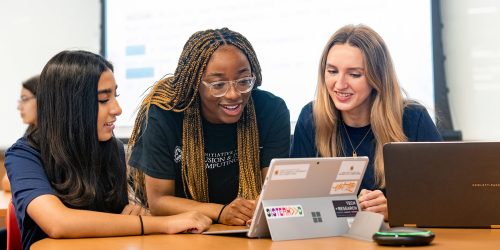
The Problem
Unequal Access to Opportunity
Paid summer internships are a proven pathway to full-time technology jobs,6 and these critical work experiences have significant economic and non-economic benefits for students.7 Research shows that landing one or more summer internships nearly doubles the likelihood of getting a job within six months of graduation8 regardless of a student’s field of study — making it one of the largest predictors of a college student’s postsecondary prospects. Paid internships also have a greater positive impact on overall career development than unpaid internships.9 Yet, recent research documents deep disparities in who gets offers for these valuable internships, and who doesn’t.10 Women, non-binary students, first-generation college-goers, Black, Latinx, Native American students, and lower-income students are all more likely to miss out on paid internship experiences — which then negatively affects the length of their job search, their satisfaction with their first job, and their early-career salaries, all of which influence how long they stay in the tech field.11
Structural Barriers in Tech-Sector Recruiting and Hiring
Company-sponsored internship programs are a key component of the tech sector’s talent development and hiring pipeline. So it is somewhat of a paradox that while most tech-sector organizations have stated diversity goals, significant structural barriers remain that impede some groups of students from getting paid internships in these same organizations. Among these is the reality that most companies:
- Limit their recruitment for internship opportunities to the same few top-tier universities, where student enrollment in computing lacks gender, racial and socioeconomic diversity;
- Use resume screeners and interview rubrics that assume candidates’ freedom to accumulate extracurricular and impressive, but often unpaid, experiences — experiences that often depend on the students’ personal and professional networks, as well as their financial ability to work for no pay;
- Do not account for a work history driven by students’ need to make money by taking on multiple part-time jobs to support their families and pay for their education.
These phenomena have been eloquently described as companies’ predisposition to conflate privilege with potential12 — a reality that results in whole groups of students simply being overlooked by the summer internship recruitment engines.

The Solution
Prioritizing Potential, Not Privilege, through Sprinternships™
Micro-internships are part of a family of innovations that are helping companies get introduced to tech talent, typically overlooked, in a shifting job marketplace. Break Through Tech’s micro-internship program, called Sprinternships™, is unique within this category because of how it is specifically designed to engage racially and economically diverse undergraduate women and non-binary students.
Micro-internships are a form of experiential learning that has been described as the tech sector’s efforts to narrow the gap between who gets access to paid internships and who doesn’t.13 They are short-term, paid, professional assignments usually undertaken by students or recent graduates who are trying to build a resume early in their careers. The duration, intensity, and compensation can all vary; but what is common among them is that the work is project-based and the time frame is brief. The theory is that students who lack an elite education can compete more effectively on the basis of demonstrated, real-world, relevant experience.
There are multiple models of micro-internships.14 Some micro-internships are fixed-fee, with payment tied to a deliverable. Others pay minimum wage for a certain number of hours on task. Many rely on the intern to independently deliver the value that the company requests, on a flexible schedule, without much supervisory support or feedback. The assignments often help fulfill a narrow company need while giving the intern an opportunity to showcase their skills and gain a valuable resume credential. Some companies are creating their own programs15 to accelerate undergraduate students’ entry into high-demand tech roles.
Sprinternships™ are a particular type of paid tech micro-internship specifically designed to meet the needs of a racially and economically diverse group of undergraduate women and non-binary students, who attend colleges and universities from which tech talent is not regularly recruited. The Sprinternship™ program is designed to provide a resume-worthy tech experience for students with a low barrier to entry for companies.
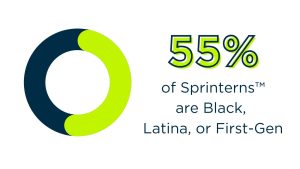 More specifically, the Sprinternship™ experience is designed to prepare students to subsequently land competitive, paid, summer tech internships that are primary launch pads into tech careers. Research shows that three things help set candidates for such internships apart: real-world experience they can put on their resume, an accomplishment they can discuss in an interview, and a network of colleagues who can offer professional references.16 The Sprinternship™ experience equips the diverse undergraduate women and non-binary students it serves with all three of these assets, therefore helping them overcome the specific hurdles to hiring that they often face.
More specifically, the Sprinternship™ experience is designed to prepare students to subsequently land competitive, paid, summer tech internships that are primary launch pads into tech careers. Research shows that three things help set candidates for such internships apart: real-world experience they can put on their resume, an accomplishment they can discuss in an interview, and a network of colleagues who can offer professional references.16 The Sprinternship™ experience equips the diverse undergraduate women and non-binary students it serves with all three of these assets, therefore helping them overcome the specific hurdles to hiring that they often face.
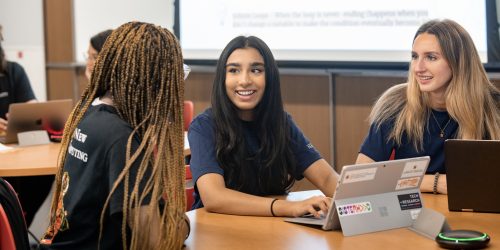
About Sprinternships™
A Micro-Internship Program
Break Through Tech’s Sprinternships™ are specifically designed to meet the expressed needs of women and non-binary students who are currently underrepresented in tech. Design features include:
- Using a cohort model because there is power in numbers.
- Focusing on first- and second-year students so that they can become more competitive applicants for paid internships later in their college careers.
- Targeting students who attend large, diverse public universities that are often overlooked by industry recruitment engines.
- Matching student teams with host companies to avoid interview bias and ensure well-balanced cohorts.
- Scheduling the program as a 3-week full-time work effort delivered during a non-summer academic break that does not conflict with traditional summer internships.
- Preparing students and employers so that expectations are aligned.
- Including both a project-based deliverable and industry immersion activities so students gain a fuller understanding of what a tech job might look like from day to day.
Each of these design features eases barriers to industry participation and increases the probability of successful outcomes for both students and their company hosts.
Placing underrepresented students who are early in their college careers into paid industry positions requires a deep understanding of what the students need to break through barriers and show their potential; and what is realistic for companies to deliver. The Sprinternship™ program, including each of the elements described in detail below, is designed to satisfy both of these challenges.
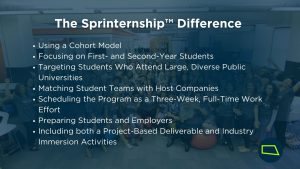
Using a Cohort Model
Students are placed in teams of five students who work collaboratively on-site17 with their employers and each other during their Sprinternship™. A team of this size helps to diversify roles and student experience and provides students with invaluable learning about working on teams — a prototypical workplace experience. For Sprinterns™, the cohort model promotes the opportunity for students to lean on each other to build confidence, develop their project-based learning, and realize their roles and assets within a team context. There is power in numbers for these young women and non-binary students. Equally important, the cohort model is easier for employers to manage, since students spend their time working together and benefit from being able to support each other.
Focusing on First- and Second-Year Students
The primary focus of most industry summer internship programs is students who have just completed their junior year (third-year students) so that employers can potentially make successful interns a full-time job offer at the end of the summer. The Sprinternship™ program is designed to make students more competitive by the time they get to this point; in other words, to give first- and second-year underrepresented women and non-binary students the boost they need to effectively compete in the traditional internship cycle during the following summer. The Sprinternship™ experience helps level the playing field for the coveted summer internship that will increase students’ prospects of landing a tech job when they graduate.
Targeting Students Who Attend Large, Diverse Public Universities
Focusing on students who attend public universities is, in part, a simple matter of solving a math problem. The 7.5 million students enrolled in four-year public higher education institutions represent twice the number of those enrolled in private four-year institutions, and nearly half of all students enrolled in college overall (as of Spring 2021). In addition, companies that are serious about diversifying their tech talent pipelines need to go where racially and economically diverse students are most likely to be — including MSI’s (Minority Serving Institutions), the colleges and universities that graduate the most women and non-binary students with computer science degrees, and universities that enroll more students from lower-income families. These are exactly the kinds of higher education institutions that Break Through Tech looks to in order to find Sprinterns™.
In many cases, the public higher education institutions that Sprinterns™attend are the local colleges in the same ecosystem as the company hosts. For the reasons described earlier, companies tend to look past these local institutions in search of tech talent. By working with these institutions, the Sprinternship™ program serves as a local economic development engine, recruiting local tech talent and supporting local industry.
Matching Student Teams with Host Companies
Teams of students are matched with a host site rather than having the host sites interview individual candidates. The matching process removes the kinds of hiring biases that can be a barrier to entry for candidates from underrepresented groups; ensures that each company will receive a team of Sprinterns™ with working styles and skills that complement one another; and boosts the chances that the Sprinterns’™ interests and expertise will be a good match for short-term success and potential future hiring at the company.
Matching is done using an algorithm that ensures that student and employer preferences — work setting availability (on-site, hybrid, or virtual), who students would like to work for, who companies would like to hire, and diversity of academic experiences — are all factored in to create optimal teams for and matches to companies.
Students and employers determine their preferences in a number of ways that vary by site, including activities like:
- independent company research by students,
- a job-fair style match event where students and company representatives have brief meetings (live or virtually),
- browseable resume books of students, or
- elevator-pitch videos from both students and companies.
Both employers and students are informed that their preferences will be taken into consideration for matching, but they are not guaranteed.
Scheduling the Program as a Three-Week, Full-Time Work Effort
Sprinternships™ take place during a time when students are on an academic break, and during a time that does not compete with companies’ traditional summer internship hiring programs. The experience lasts for three weeks. Both timing and duration are important elements of success for the Sprinterns™ and for their company hosts.
The timing allows companies to have the benefit of what amounts to a three-week interview at a time in their annual cycle when they are not typically supporting other student workers. It also ensures that they get introduced to internship candidates they would typically overlook in their standard recruitment practices. The students can participate in the experience on a full-time basis at a time when they are not also navigating the demands of coursework.
The three-week duration gives companies a real feel for the talents and dedication of a diverse group of students. Hosts can see students’ growth from day one to their final presentation. Year after year, employers are impressed by what Sprinterns™ can accomplish in just a few weeks. Students, in turn, spend enough time immersed in a company’s day-to-day culture to feel like they belong there and can speak about the company, their role, and their accomplishments in a corporate context during future job interviews.
Preparing Students and Employers
Break Through Tech thoroughly prepares both students and employers for the Sprinternship™ in advance, representing a level of support that is uncommon for micro-internship experiences and that contributes greatly to the program’s success.
Many first-time Sprinterns™ have no experience working in an industry office environment (virtual or on-site) or in tech roles. Student preparation workshops cover professional goal-setting, understanding organizational culture, working in teams, tech project management, and common software tools. Some Break Through Tech sites also provide weekly coaching to each team during the Sprinternship™. This eases the transition from the classroom to the workplace and encourages students to advocate for themselves and to problem-solve.
In addition, Sprinternships™ are often the first time that company staff have supervised less experienced students from more diverse backgrounds. Employer preparation offers guidance about how to frame three-week-long “challenge projects,” encourage and onboard students new to the workplace, design a schedule for Sprinterns™ that balances technical projects with company exposure and cultivate an inclusive environment and sense of belonging.
Including both a Project-Based Deliverable and Industry Immersion Activities
Employers design challenge projects as creative sprints for students. These projects address real business issues and invite students to imagine how companies might use a technical solution to do something differently.
Host companies often frame a challenge for their Sprinternship™ teams by asking the question: “How might we…?” Sample projects have focused on answering questions like:
- How might we integrate technology into a retail store to improve the customer experience?
- How might we create a portal for internal staff to access a variety of company information, that would be more useful and interactive?
- How might we use chatbot technology to improve the customer experience in a specific business unit?
- How might we create dashboards to facilitate the analysis of data from various systems?
- How might we create a predictive model to improve marketing or operational success metrics for an organization?
The host company provides Sprinterns™ with a structure for how to approach a problem, ideate, and then design a solution that addresses the challenge. Challenge projects can be concrete or conceptual in nature and typically result in a prototype that Sprinterns™ present to the employer’s leadership team in a final team presentation.
By working on this project throughout their Sprinternship™, students gain experience in team collaboration, product/system design, project management, coding implementation, and public speaking. Challenge projects provide hands-on experience in a real-world setting that leaves students with a portfolio project that they can show on a resume or talk about in an interview as well as the confidence that can only be gained by doing.
Company Immersion to Grow Students’ Knowledge, Confidence, and Networks
Sprintership™ hosts make sure that students are immersed in the company’s culture, routines, and day-to-day priorities. Sprinterns™ are introduced to colleagues who hold a variety of jobs, participate in department meetings, receive invitations to company events, and have the opportunity to meet with senior leadership. During their Sprinternship™, students are able to get a better understanding of an employer’s core operations, what their business model is, how they define success, the career roles that are available, and the paths employees have taken to get where they are. They walk away from the experience with new knowledge and confidence, an ability to speak about their company host during an interview, and a network they can continue to tap into.
Pete Irwin, Principal in Data, Analytics, and AI at KPMG, said his team spent a lot of time preparing for their Sprinterns™ to arrive. “We planned a schedule with all of these activities on wellbeing in the workplace, cultural and technical skills, and job shadowing that they participated in on top of their project.” Pete said he learned that “making connections with this ambitious, diverse group of students is incredibly valuable. These Sprinterns™ have an appetite to succeed and they want to do a lot. We look forward to our next cohort.”
What Do Sprinterns™ Do?
Sprinterns’™ schedule during the three weeks includes time to work on the challenge project as well as activities that immerse them in the business and that allow them to explore possible career pathways. These might include team or organization-wide meetings, workshops on technical functions, “lunch and learns” with their colleagues, meetings with executives from all parts of the business, mentorship or coaching, targeted job shadowing, or guidance about how to apply for the company’s summer internship program. The combination of meetings and time to work on assigned projects resembles a tech worker’s typical daily work schedule. See a sample 3-week schedule.
Each three-week sprint ends with a team presentation of their recommended solution, including a discussion of how they investigated the question, a presentation of any analytics or prototypes, what they would do next if they had more time, and what they learned working on the project.
Data Analysis
Between 2017 (the pilot year) and 2022, 1,246 students participated in the Sprinternship™ program. Annual and cumulative participation data are shown in Table 1.
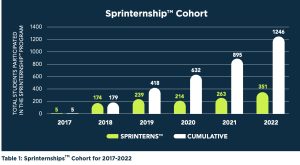
96% of Sprinterns™ identify as female or non-binary, 50% are first-generation college-goers, 11% are Black, 16% are Latina, 5% are multi-racial including Black and/or Latina, 53% are Asian, 13% are White, and 2% are multi-racial White and Asian. In total, 55% of Sprinterns™ are Black, Latina or First-Gen. While we don’t have specific socioeconomic data for our Sprinterns™, on average, students attend universities where 59% of students are eligible for Pell grants.
The results section that follows is based on survey data from all Sprinterns™ to date.
RESULTS FOR STUDENTS
Landing a paid summer internship in tech gives students a definitive boost towards a full-time, post-graduation technology job. Therefore, Sprinternships’™ primary intended outcome for students is to substantially increase their chances of landing that coveted paid summer internship. The program design elements are a means to that end.
Data from our first partner university showed that prior to the Sprinternship™ program, only about 4% of the women who were seeking paid tech internships (primarily juniors and seniors in college) were successful in landing one.21
Post-Sprinternship™ survey data shows that students were more than 10 times as likely to land a paid summer tech internship after completing a Sprinternship™ experience. More specifically, 59% of the Sprinterns™ landed employment during the following summer, whether at their Sprinternship™ host company or elsewhere.
This is a remarkable change from our baseline data, as shown in Table 2.
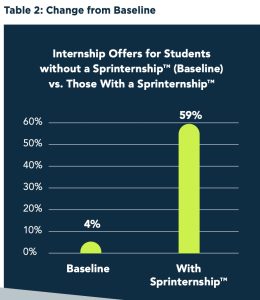
What’s more, in 2022, 80% of the Sprinterns™ who applied to their host company for a summer internship received an offer from these companies — making it clear that the Sprinternship™ program introduces participating companies to a highly diverse internship tech talent pool in a way that effectively and efficiently leads to a more diverse employee candidate pool and ultimately a more diverse workforce.
In addition, 64% of our students have received a summer internship offer from a company other than their Sprinternship™ host company — showing the enormous impact that this three-week intensive experience and resulting resume credential can have on a student’s education-to-career trajectory.
We also considered the impact of two other variables on the success of our Sprinterns™ who were seeking a Bachelor’s degree in landing a paid summer tech internship: years to graduation and race/ethnicity.
Years to Graduation
The focus of most industry summer internship programs is students who have just completed their junior year so that employers can potentially make the successful interns a full-time job offer at the end of the summer. Some companies will extend offers to students just completing their sophomore year as well — hoping to pipeline them into a second internship the following summer and then a full-time job offer. Few, if any, companies make paid summer internship offers to students just completing their first undergraduate year.
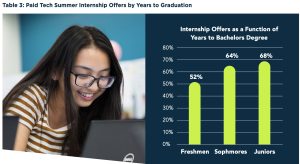
Table 3 shows that all of the Sprinterns™, regardless of years to graduation, showed at least a 10-fold increase in their ability to land a paid tech summer internship as compared to our baseline data. What is surprising and important is that 52% of the students who were first-years at the time of their Sprinternship™ were offered a summer internship — in spite of the reality that most companies typically do not offer these opportunities to students at this early stage of the college journey. Again, this makes clear that when companies employ a structured program like a Sprinternship™ to introduce diverse groups of undergraduate women into their talent pipeline, these students demonstrate their potential as future employees. This is an extraordinary outcome and clearly sets these young students on a trajectory toward success that they would not otherwise have achieved.
It is not surprising that juniors achieved the highest success rate (68%), as this is the year in school that most companies target for their internship program. What is impressive, however, is that sophomores were almost equally as successful; setting these students up for success in their remaining two years of undergraduate school and again, showing what can happen when these students get a chance to demonstrate their potential and their resumes reflect this highly valued experience.
Race and Ethnicity
Break Through Tech’s experience working at large, diverse, public universities — confirmed by our baseline data — suggest that regardless of demographic identifiers, students who attend non-top-ranked universities are routinely overlooked by the recruiting engines of industry. However, it’s also true that the intersection of race, ethnicity, and gender can further compound the challenge for students. Not surprisingly, there’s still work to do to close the gaps.
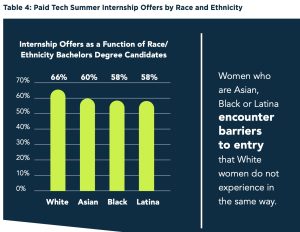
Our results show that disparities still exist with respect to race and ethnicity and that we still have work to do in order to increase the success of Sprinterns™ of color. As shown in Table 4, Asian, Black, and Latina Sprinterns™ were all offered paid summer internship opportunities 6%-8% less often than their White peers. Our results confirm that women who are Asian, Black, or Latina encounter barriers to entry that White women do not experience in the same way. This inequity deserves our attention. On a positive note, all students — regardless of race or ethnicity — achieved an offer rate that is at least a ten-fold increase over baseline.
WHAT EMPLOYERS SAY
Host companies report that there are three main benefits to participating in a Sprinternship™ program: building their talent pipeline, investing in equity, and getting fresh perspectives.
Building the Pipeline
Sprinternship™ hosts see their Sprinterns™ as potential future interns and colleagues. They invest their time and effort in the program because it brings to their doorstep a diverse population of talent that their standard recruitment practices typically overlook. With that in mind, it is important to note that many host companies report that their offer-to-accept rate for summer internships is higher among Sprinterns™ than among intern candidates recruited through their traditional strategies.
The expansion of Sprinternships™ to cities across the country allows students to be part of a broad network. Companies report that having geographic flexibility is a significant benefit. Many of our partner companies host Sprinterns™ in multiple cities each year.
Investing in Equity
Beyond the goal of direct recruitment, many companies that host Sprinterns™ do so in order to help level the playing field for the whole industry. While it makes good sense for the participating company’s bottom line, they also see the program as a way to contribute to the future of tech. Additionally, companies report that the program inspires their own employees to contribute to the future of the tech field and provides leadership development experiences for their young leaders.
Getting a Fresh Perspective
Bringing in more diverse talent brings new perspectives. While three weeks might not seem like enough time to dig into a project, Sprinterns™ have proven every year that this is not true. Companies uniformly report that they are surprised by what the students can accomplish in such a short period of time — sometimes seeing a solution that no one else has seen yet — and allowing companies to quickly assess what the students are capable of.

Expanding Innovation & Impact
A Call to Action
The Sprinternship™ program has proven to be an innovative and effective strategy for companies who are interested in diversifying their tech workforce. Increasingly, companies are seeing this program as a strategic part of their talent acquisition effort. One of our host companies made internship and/or job offers to over 60% of their Sprinterns™; nearly 90% of the offers were accepted. Some companies (e.g., American Express) have already started working with Break Through Tech to source large numbers of Sprinterns™ from higher education institutions in multiple cities, and to place these students in the company’s strategic tech hubs for the three-week program duration. 
The program also supports local economic development groups by giving these organizations a proven tool they can bring to their constituency, which includes both local employers and local public colleges. As surprising as it may seem, local employers — who typically have a challenge competing with the big national players for tech talent — still often ignore the wealth of talent sitting in their own backyards. Break Through Tech’s Sprinternship™ program provides an innovative glide path into a tech career for underserved students in their region — and at the same time, supports the needs of local industry.
These are just two of the ways that Break Through Tech is scaling the program with partners to ensure that continuing program innovation responds to the tech sector’s interest in a diverse pipeline of talent and to undergraduate women’s interest in pursuing a tech career.
CALL TO ACTION
Any company that has the resources to run a paid summer internship program, and cares about diversifying tech talent, should also run a Sprinternship™ program. It’s proven to be strategic and effective for companies who meet the “model host” criteria in the box on this page. If you are interested in getting involved in this innovative approach to solving the opportunity challenge that underrepresented groups in tech face, contact Break Through Tech to learn more about how to bring a Break Through Tech Sprinternship™ program to your city or company.
Is Your Organization a Good Fit?
- Sharing a goal: achieving gender equity in tech — The program rests on the notion that industry partners have tech talent recruitment goals that are aligned with Break Through Tech’s mission to propel more women, non-binary students, and underrepresented communities into tech education and careers. Model host companies have stated internal goals to hire for greater diversity, and they have dedicated the financial and staff resources necessary to achieve their goals.
- Investing in preparation: on both sides of the relationship — Model host companies take the time and are intentional about providing a welcoming and supportive Sprinternship™experience for students, which ensures that students feel valued and want to continue working with the company. Break Through Tech’s preparation for Sprinterns™ before they begin their placement in a partner company ensures that students are prepared to work in an office environment, are ready to work in teams, and are equipped with comparable technical and project management skills. Most importantly, it gives students the confidence to excel in this environment.
- Driving growth: partnering to expand the program model — Given the success of the program, model host companies will consider the program part of their talent acquisition strategy and use the program to fundamentally shift the makeup of their internship cohorts and, by extension, their entry-level hires.
Endnotes
- While this document uses “women” to describe Sprinternships’™ primary audience, the program includes all female-identifying and marginalized genders, with a particular emphasis on Black, Latina, Indigenous, low-income, and first-generation college women. In addition, in compliance with Title IX of the Education Amendments of 1972, all students underrepresented in tech fields are welcome to participate in Sprinternships.™
- One source estimates that of the 4.7 million computing-related jobs available by 2030, only 20% will be able to be filled by US college graduates. See Bureau of Labor Statistics projections, as reported by National Center for Women in Technology, https://ncwit.org/resource/bythenumbers/
- See Table 318.30, “Bachelor’s, master’s, and doctor’s degrees conferred by postsecondary institutions, by sex of student and field of study: 2018-19,” https://nces.ed.gov/programs/digest/d20/tables/dt20_318.30.asp
- See Table 325.35, “Degrees in computer and information sciences conferred by postsecondary institutions, by level of degree and sex of student: 1964-65 through 2018-19,” https://nces.ed.gov/programs/digest/d20/tables/dt20_325.35.asp
- See, e.g., Pew Research Center, STEM Jobs See Uneven Progress in Increasing Gender, Racial and Ethnic Diversity | Pew Research Center; Women in Tech Statistics Show the Industry Has a Long Way to Go
- See, e.g., this report from National Association of Colleges and Employers, Job Offers for Class of 2019 Grads Impacted by Internship Experience; Zilvinskis, John; Gillis, Jennifer; Smith, Kelli K., Unpaid versus Paid Internships: Group Membership Makes the Difference, Journal of College Student Development, v61 n4 p510-516 Jul-Aug 2020.
- See this report from Strada Center for Education Consumer Insights, based on analysis of three different nationally representative surveys: https://cci.stradaeducation.org/pv-release-march-16-2022/.
- Townsley, E., Lierman, L. Watermill, J. and Rousseau, D. The Impact of Undergraduate Internships on Post-Graduate Outcomes for the Liberal Arts, National Association of Colleges and Employers, September 2017.
- See Crain, Andrew, The Impact of Unpaid Internships on College Student Career Development and Employment Outcomes, National Association of Colleges and Employers, December 2016. https://www.naceweb.org/uploadedfiles/files/2016/guide/the-impact-of-unpaid-internships-on-career-development.pdf
- See, e.g., this data from the 2019 NACE Student Survey Report; this 2020 analysis from New America, including references to relevant academic studies and industry surveys; and this 2022 policy brief, “Unpaid Internships and Inequality: A Review of the Data and Recommendations for Research, Policy and Practice.”
- See, e.g. this 2019 study from National Association of Colleges and Employers (NACE); this Harvard Business Review article, which cites the NACE study, ; and this Forbes article, citing multiple sources.
- Franklin-Davis & Farmer, Tech companies: Stop conflating privilege with potential | TechCrunch
- “Why Micro-Internships Will Be the Next Big Thing,” Dr. Jason Wingard in Forbes.com, March 6, 2019. https://www.forbes.com/sites/jasonwingard/2019/03/06/why-micro-internships-will-be-the-next-big-thing/?sh=14ce02700cb1
- One widely cited example is Parker Dewey (https://www.parkerdewey.com/projects/tag/it-cyber).
- Salesforce’s FutureForce Tech Launchpad partnership with CodePath, new in 2022, is one example. See this article: https://www.protocol.com/workplace/salesforce-futureforce-launchpad-internships
- Don’t Just Pay Interns, Help Them Build Networks, Freeland Fisher, Julia, in Harvard Business Review, May 2022.
- While it has historically been preferable for Sprinternships™ to be in-person and on-site so that students get experience working in a real-world business environment, the COVID pandemic has dramatically changed what the business environment looks like. As a result, our Sprinternships™ currently include in-person/on-site, fully remote, and hybrid experiences.
- The Sprinternship™ program does not exclude third- and fourth-year students from the cohort if they have not previously had a paid summer tech internship.
- https://nscresearchcenter.org/wp-content/uploads/CTEE_Report_Spring_2021.pdf
- Judith Spitz, in Forbes.com: Tech Summer Internships Version 2.0: Why CIOs And CTOs Should Repurpose Their Summer Internship Programs As Diversity Initiatives
- While informal reporting suggests that students who attend top-ranked universities almost certainly achieve higher placement rates for paid summer tech internships, Break Through Tech’s experience with a number of university partners and published data (see Footnote 11) suggests that students with our demographic profile do not achieve comparable results.
